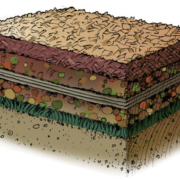Healthy, living soil is full of oxygen, water, and life to support your plants. Building healthy soil using layers uses a process called soil sheet mulching, or “Soil Lasagna.” If you have ever cooked lasagna, this will seem familiar. Soil Lasagna boosts healthy microbes so much that they actually cook down the organic matter and start eating old grass in your landscape as food.
Once you’ve created Soil Lasagna, all you need to do is keep it moist so the microbes will stay active. How long the process takes from start to finish depends on the kind of grass you have. When you are ready to plant, you can dig a hole right into it, cutting through any paper or cardboard that might still be there, planting in the delicious and healthy soil below.
Supply List to Create Soil Lasagna
-
- Shovels and rakes
- Wheelbarrow(s)
- Bins to hold removed grass and soil
- Mulch
- Landscape flags
- Painters’ paper or large cardboard sheets
- Compost, worm castings, or compost tea
- Hose with a shutoff nozzle
NOTE: If you need any permits, call DIG ALERT (8-1-1) two days in advance. Also, check with your local water agency for any local water use restrictions.
Once you have checked for permits and any water-use restrictions, you will need to remove your lawn. See our previous column on removing your lawn without killing the existing microbes. You will end up removing about six inches deep of grass and soil. You will need to haul this away. Consider renting a dumpster.
Dig a trench 8 to 12 inches deep (about one shovel depth), and 12 to 24 inches wide around any hard surfaces and building foundations. Also, complete contouring for rainwater absorption and retention and any other hardscaping such as moving or installing patios, paths and other features.
Use landscape flags to mark sprinkler heads so you can find and adjust them later.
Layers Are Key To Your Soil Lasagna
Add an inch deep layer of compost on top of the graded soil. You can also use humates (a freeze-dried compost available at specialty landscaping stores) or spray with compost or worm tea. You are adding an instant food sources and additional microbes to the soil.
Water thoroughly. Roll out your painters’ paper or cardboard. Overlap at the seams about six inches and be sure all of the soil is covered. At the hardscape borders, make a burrito of rolled paper and mulch to prevent grass from resprouting.
Water the paper, and then add another layer of compost if you wish. Rake a thick, six-inch larger of mulch over the paper and compost. Now you’re seeing why this is called a Soil Lasagna.
Water again thoroughly. The mulch will absorb a lot of water before it becomes soaked through.
You can plant right through the Soil Lasagna layers. If you can wait, the soil will develop more healthy microbes for new plants, but you can plant right away if the grass has been removed.
Finally – step back and savor your hard work!
This article was inspired by the 71-page Sustainable Landscapes Program guidebook available at SustainableLandscapesSD.org. Hardcopies are available free of charge at the Water Authority’s headquarters, 4677 Overland Ave., Kearny Mesa. The Water Authority and its partners also offer other great resources for landscaping upgrades, including free WaterSmart classes at WaterSmartSD.org.



